Meet the Hewitts: Part Thirteen


Meet the Hewitts: Part 12 sent you digging in the Ringwood gardens. This snippet follows Sarah and Eleanor through their lifetime of travel.
Margery Masinter, Trustee, Cooper Hewitt, Smithsonian Design Museum
Sue Shutte, Historian at Ringwood Manor
Sarah and Eleanor accompanied their parents—Abram and Sarah Amelia—on yearly voyages to Europe throughout their childhood and teen years. These excursions were considered part of their education. The young women learned to be curious and discriminating, and began to specialize in “shopping” for treasures for the Hewitt homes and, later, for their museum. The following excerpts and stories from letters, diaries, postcards, and magazines reveal how two energetic women methodically plotted to see as much as possible during their lengthy sojourns. Long, witty letters and snapshots combine to form a colorful and rich log—as if we were privy to the sisters’ Facebook, Instagram, and Twitter posts!
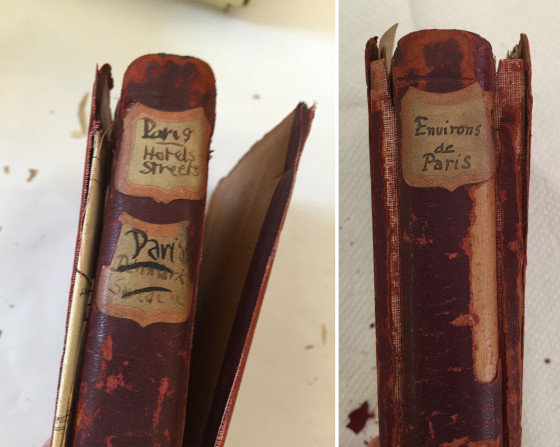
Two of the Hewitt sisters’ French travel diaries. (See Meet the Hewitts: Part Nine for more information on the travel diaries.) Cooper Hewitt Design Library.
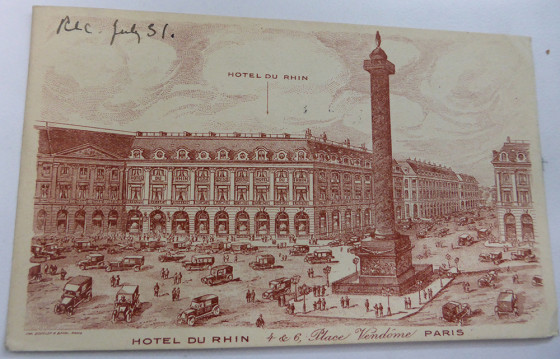
Hotel du Rhin, postcard. Sarah and Eleanor often stayed at this hotel at 4 Place Vendome. It was originally designed by Mansard and completed in 1701. Cooper Hewitt Postcard Collection.
The American Illustrated weekly magazine noted in May 1891 that “the clever daughters of Abram Hewitt” were on a mysterious mission: “The Misses Hewitt propose to inaugurate in New York a work as yet unknown in this country.” Sarah and Eleanor, ages 31 and 27, were observed “taking keen and intelligent interest” in galleries, museums, and bric-a-brac shops in Paris, spending more time than usual in that city. “No new thing deserving of attention escaped their comprehensive vision.” Their plan to establish a museum at Cooper Union—the school founded by their grandfather Peter Cooper—was firmly planted.
The sisters’ trips were well-planned affairs. This map, found folded into one of Eleanor’s travel diaries, clearly illustrates how to explore by car without disturbing cyclists, and emphasizes the importance of studying the routes prior to departure. In 1908, a project called the “Outlets of Paris” was initiated to define the major routes by which one could exit Paris and eliminate “complete disorder” with respect to automobile drivers and cyclists, so that “every mode of transportation adopts the route that is proper to it.” (trans.) The Touring Club de France (TCF), recognized as a public utility in 1907, focused on the development of touring and tourism in all its forms and supported the creation of this kind of information.
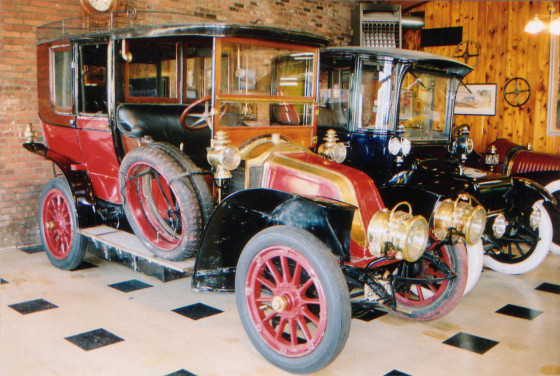
1905 Renault Town Car. Inscription on plaque on dashboard reads: “Miss Sarah Cooper Hewitt, 9 Lexington Avenue, New York”; the reverse side reads: “Miss Sarah Cooper Hewitt, Hotel du Rhin, Place Vendome, Paris.” A luggage rack to accommodate trunks is on top.
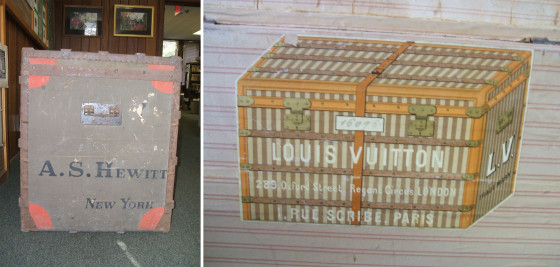
Louis Vuitton steamer trunk and interior label, owned by Abram S. Hewitt. In 1858, Louis Vuitton introduced his “Trianon” model, a grey canvas flat trunk that could be stacked with ease for voyages. Vuitton opened his London store in 1885. Sarah and Eleanor traveled with similar steamer trunks. Courtesy of Ringwood Manor.
In August 1908, Eleanor typed a long letter to her close friend Edith Wetmore, who needed advice on an upcoming trip to Europe. Excerpts from the letter (found tucked into one of the travel diaries) show how methodical Eleanor was in listing the sites to see and the best way to see them.
To be seen near Paris are: Bagatelle, Bois de Boulogne. Built by Comte d’Artois, woodwork and hangings untouched. . . . Chateau de Dampierre, can be seen Fridays by writing for permission to the Duchesse de Luynes at Dampierre, fine gardens, moats, furniture, escaped Revolution. . . .Chateau de Rambouillet, can be seen everyday when the President is not living there. Best règence boiseries in existence. . . . “Chateau de Maintenon, good hotel” . . . Chateau de Chantilly. . . wonderful monkey room painted by Watteau . . . Chateau de Ferrieres. Write for permission to Mme de Rothschild. . . Chateau de Vaux le Vicomtes . . . Best 17th century chateau have ever seen. Prettiest road to Versailles by auto . . . Sèvres, be sure to see the ceramic museum, upstairs particularly. . . .
She continues with an exhaustive description of more sites, gardens, routes, places for lunch, how to get permissions, etc., and concludes, “I can’t think of more as I have no notes with me.”
As avid gardeners, Sarah and Eleanor scheduled visits to the great gardens of Europe on their yearly itinerary. Sarah often typed her letters double spaced on 5” x 8” note cards. An excerpt from a note card to her friend Sue Bliss reads: “Here are the seeds of the Umbrella Pine and Black Cypress from Lake Garda . . . . My gardener has been experimenting with the seeds all winter in the greenhouse & this is the way he finally got them to grow. . .” She goes into great detail about planting and continues to say that she gave the seeds to Edith Wetmore and many other friends, and “is deeply interested to see who will have the best luck.” (A travel diary entry records the sisters’ visit to Lake Garda, Italy, in 1914.) In 1920, Sarah was back in Europe collecting statuary for her gardens, and in another letter to Sue wrote that “[o]ur Bernini marble statue arrived yesterday . . . weighing 3 tons. . . “!
The sisters’ annual visits to Europe halt with World War I. Their travel diaries from 1914 to 1919 record their itineraries in the United States, covering as much territory as possible and alphabetically listing destinations within each state. They visited museums, colleges, historic sites, Civil War battlefields, and mansions seeking information about artistic treasures throughout New England, the Middle Atlantic, and Southern states. They met with historians and collectors and stayed with friends when possible. Every day another place and another hotel! Their mode of travel is not described in the travel diaries, but they probably traveled by chauffeured car and train.
In August 1915, Sarah wrote to Mrs. Bliss:
Our brains are really architectural omelettes [sic] for it is impossible to remember half of what we have seen. . . .
The Cooper Hewitt Postcard Collection comprises ten thousand cards contained in fifty file card drawers, meticulously organized alphabetically within many subject categories. The collection focuses primarily on view cards of European domestic, public, and religious architecture; famous gardens; and interior decorative arts and design. The postcards are important historical documents as many of the sites were destroyed or altered during the World Wars. Sarah and Eleanor were involved in the building and maintenance of the collection, collecting packets of cards on their trips and adding cards to and from family members and friends.
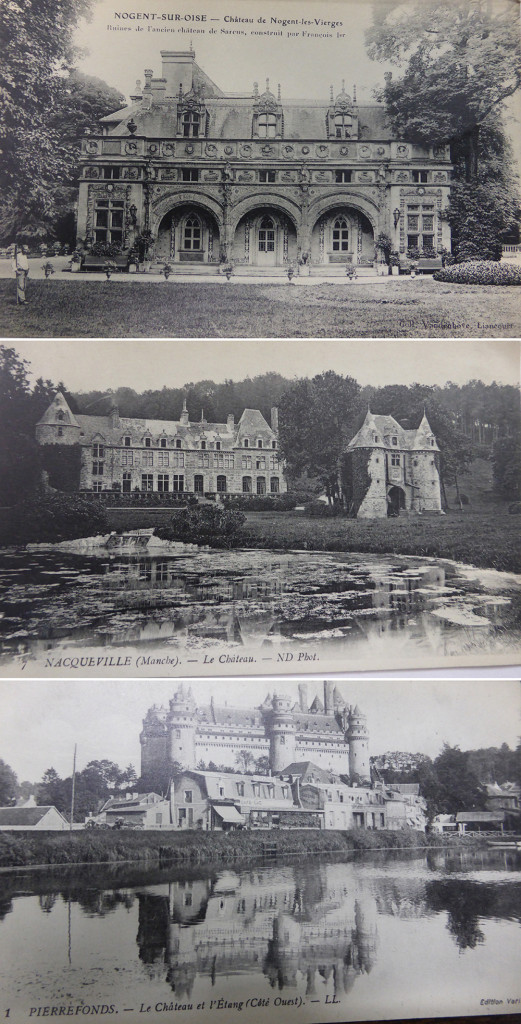
Postcards of village chateaux, which are still open to tourists. The medieval Chateau Pierrefonds was restored by Violette-le-Duc in the mid-19th century. You can rent it today for private parties and concerts! The cafe and other commercial structures have been removed, but it’s interesting to see how it looked in the early 20th century.
Smithsonian Institution Archives, OSIAREF@si.edu. See Online Record Unit 000267, where a small selection of personal letters to and from Eleanor and Sarah Hewitt are preserved. These letters to friends exhibit their wit, intelligence, and outgoing personalities.
Here’s a story from Sarah in 1920 about a travel incident, excerpted from an eight-page typed letter to Sue Bliss, where she ended the letter referring to herself as a “Babbling Brook”:
“LATEST EXTRY, LATEST EXTRY.” MISS HEWITT’S CAR BROKEN INTO AND ROBBED ON THE ROAD FROM BAR HARBOR TO RINGWOOD, N.J.” [Letter continues about the robbery of her belongings from an Erie R.R. car.] all our trunks were broken open and rifled and the contents thrown all over the car . . . even the Germans could not have wrought more havoc, the trunk tops pried off by crowbars wrenching the Vuitton locks apart . . . an indescribable mess and scene of ruin. [Letter continues that nothing of value was stolen, and that the robbers were searching for drink.] What a commentary this is on Prohibition that a few poor thirsty R.R. hands, too poor to buy what the richer people can get so easily are are forced to to become thieves and burglars . . . It is needless to say that during the robber mélée, our 60 bushels of Maine Seed Potatoes were tramped so heavily under foot . . . that they will be rendered useless for seed, and I wonder if I can ever collect damages . . . the R.R. may only give us the value of edible potatoes. . . .
[U.S. Prohibition, 1920–1933]
Ringwood Guest Books
http://www.ringwoodmanor.org/ringwood-manor-guest-books.html
See Meet the Hewitts: Part 5 and Meet the Hewitts: Part 8.
Although the sisters didn’t travel to Europe from 1914–19, they were deeply concerned and involved in raising money to aid in the war effort. Their good friends designer Elsie de Wolfe, theatrical producer Elizabeth Marbury, and philanthropist Anne Morgan, daughter of J.P. Morgan, converted their home in Versailles—the Villa Trianon—into a French military hospital. Anne was devoted to the French cause and founded a formidable help organization, the American Friends of France (AMF), at Blérancourt. In September 1918, Caroline Durer visited Blérancourt and later posted these photographs in the Ringwood Guestbook dated 1902 to 1932. Her poetry about the war and other expressions of concern by Ringwood visitors are noted in this guest book.
One thought on “Meet the Hewitts: Part Thirteen”
Antonio de Llamas on July 1, 2015 at 3:30 pm
Dear Margery
I have been reading all your snippets “Meet Hewitts” and they are amazing,
I just finished Part Ten and felt all the love and dedication you put on them, thanks!
I work in Mahwah, NJ (very close to Ringwood) as Director of R&D of a graphic & textile company and I love design, drawing and photography since I was a teenager back in Argentina
One beautiful day two weeks ago I went for lunch in the backyard of Ringwood Manor in my motorcycle, and I almost felt the spirits of Sarah, Eleanor and the whole family and very special guests that I find so close to my essence, since I am an inventor and artist myself, with strong interests in philosophy, science, technology, mechanics, etc. some sort of renaissance man which is becoming less frequent in modern times of hyper-specialization
Like the Cooper-Hewitts I also come from a family of founding people, specially my grandfather, doctor, politician, several times Mayor of his town in the 1920’s when that territory was very much like the Far West in the US , and founded the public hospital that still carries his name for free medial assistance for everyone
Your snippets also motivated me to know more about Peter Cooper and learn war a truly great men he was, next time I pass by Cooper Square in NYC I leave a flower in his statue, I can only imagine how many people benefited from his pioneer spirit over the last century…
Best regards
Antonio